Geothermal energy could be the solution to all our energy needs – present and future, experts say. The source is nearly inexhaustible, and is located just under our feet. We only need to reach out and take it.
Geologists estimate that massive amounts of heat exist in the planet's crust, mantle and core. They say that about 99 percent of Earth's mass is heated to well beyond 1,000 degrees Celsius.
If we were to become capable of capturing and converting at least a very small percentage of all this energy into electricity, then we would no longer require fossils fuels such as coal, oil and natural gas.
The high temperatures that exit within the planet endure since billions of years ago, when Earth first solidified from a ball of incandescent magma that was spinning around the Sun.
“If we can drill and recover just a fraction of the geothermal heat that exists, there will be enough to supply the entire planet with energy – energy that is clean and safe,” explains SINTEF Materials and Chemistry senior researcher Are Lund.
He goes on to say that this form of energy releases zero carbon dioxide emissions, which means that it's also good for the environment. The lower you go into the crust and mantle, the more energy you are able to extract from this heat.
Additional heat in the rock layers comes from radioactive materials inside the mantle, which progressively decay, and send heat through the rock layers above, AlphaGalileo reports.
“If we manage to produce this kind of energy, it would clearly be a ‘moon landing’. This is one of the few sources of energy that we really have enough of,” says SINTEF researcher Odd-Geir Lademo.
“The only thing that we need is the technology to harvest it,” he adds further. The scientist says that, if drilling workers can reach 10,000 meters, then geothermal energy production would increase its efficiency 10 times over, above today's levels.
Supercritical water at these locations would have a temperature of about 374 degrees Celsius, and would be subjected to a pressure of 220 bars at the very least. The amount of heat such water includes is tremendous.
There are also some hurdles in this field, such as for example the fact that electronics and materials give way at large temperatures and pressures. This means that drills cannot go very deep. “We have a strong and innovative oil industry [in Norway]. Because the oil industry has wanted to develop oil and gas deposits from inaccessible areas, drilling technology has evolved tremendously over the past ten years, Lund and Lademo say.
“There are test wells for oil that go 12 000 meters into the Earth. Knowledge from the oil and drilling industry may be used in the future to capture geothermal energy,” they conclude.

 14 DAY TRIAL //
14 DAY TRIAL //